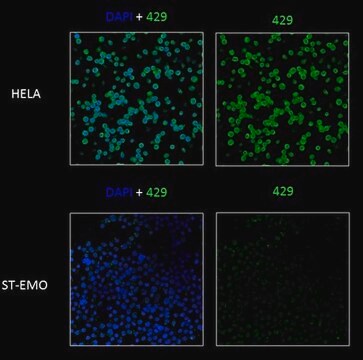MABF125
Anti-TAP1 Antibody, clone mAb 148.3
clone mAb 148.3, from mouse
Synonym(s):
Antigen peptide transporter 1, APT1, ATP-binding cassette sub-family B member 2, Peptide supply factor 1, Peptide transporter PSF1, PSF-1, Peptide transporter TAP1, Peptide transporter involved in antigen processing 1, Really interesting new gene 4 prote
About This Item
Recommended Products
biological source
mouse
Quality Level
antibody form
purified immunoglobulin
antibody product type
primary antibodies
clone
mAb 148.3, monoclonal
species reactivity
human
technique(s)
activity assay: suitable
immunofluorescence: suitable
immunoprecipitation (IP): suitable
western blot: suitable
isotype
IgG1κ
NCBI accession no.
UniProt accession no.
shipped in
wet ice
target post-translational modification
unmodified
Gene Information
human ... TAP1(6890)
General description
Immunogen
Application
Western Blotting Analysis: A representative lot from an independent laboratory detected TAP1 in microsomes of baculovirus-infected SF9 cells, which express wild type or select mutations of TAP1 (Chen, M., et al. (2004). J Biol Chem. 279(44):46073-46081.).
Western Blotting Analysis: A representative lot from an independent laboratory detected TAP1 in SF9 cells infected with recombinant baculovirus containing TAP1 gene constructs (Meyer, T. H., et al. (1994). FEBS Lett. 351(3):443-447.).
Immunofluorescence Analysis: A representative lot from an independent laboratory detected TAP1 in HeLa cells contransfected with wild type TAP1 and TAP2 (Hulpke, S., et al. (2012). Cell Mol Life Sci. 69(19):3317-3327.).
Immunofluorescence Analysis: A representative lot from an independent laboratory detected TAP1 in SF9 cells infected with rBV-TAP1/rBV-TAP2 (Meyer, T. H., et al. (1994). FEBS Lett. 351(3):443-447.).
Immunoprecipitation Analysis: A representative lot from an independent laboratory immunoprecipitated TAP1 from SF9 cells infected with rBV-TAP1/rBV-TAP2 (Meyer, T. H., et al. (1994). FEBS Lett. 351(3):443-447.).
Activity Assay Analysis: This antibody inhibits TAP-specific peptide transport (Plewnia, G., et al. (2007). J Mol Biol. 369(1):95-107.).
Quality
Western Blotting Analysis: 0.5 µg/mL of this antibody detected TAP1 in 10 µg of Interferon-gamma (IFN-g) treated HeLa cell lysate.
Target description
Physical form
Other Notes
Not finding the right product?
Try our Product Selector Tool.
Storage Class
12 - Non Combustible Liquids
wgk_germany
WGK 2
flash_point_f
Not applicable
flash_point_c
Not applicable
Certificates of Analysis (COA)
Search for Certificates of Analysis (COA) by entering the products Lot/Batch Number. Lot and Batch Numbers can be found on a product’s label following the words ‘Lot’ or ‘Batch’.
Already Own This Product?
Find documentation for the products that you have recently purchased in the Document Library.
Our team of scientists has experience in all areas of research including Life Science, Material Science, Chemical Synthesis, Chromatography, Analytical and many others.
Contact Technical Service








